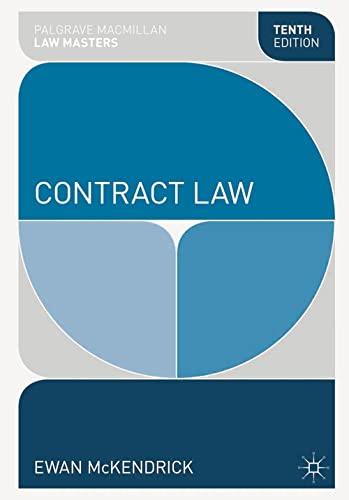Question
In 2005, bankruptcy reform laws: required debtors to pay more of their debts in bankruptcy. increased the amount of possessions a debtor may retain in
In 2005, bankruptcy reform laws:
required debtors to pay more of their debts in bankruptcy.
increased the amount of possessions a debtor may retain in bankruptcy.
allowed debtors to have more of their debts discharged in bankruptcy.
made student loans dischargeable in bankruptcy.
Assessment question
Which of the following is the lowest priority of claims in bankruptcy?
alimony
debts for injury caused by drunk driving
medical debts
mortgage on a principal residence
Assessment question
The Bankruptcy Code exempts (limited to a certain dollar amount) which type of property?
cash
jewelry
family heirlooms
one vehicle per driver in the household
Assessment question
Which of the following statements is true about assets in the bankruptcy estate?
The majority of states require debtors to follow state exemption guidelines instead of federal guidelines.
The majority of states require debtors to follow federal exemption guidelines instead of state guidelines.
In the majority of states, federal and state exemption guidelines are the same.
The majority of states give debtors a choice between state and federal exemption guidelines.
Assessment question
Which of these statements are true about involuntary bankruptcy proceedings? Choose 2 answers.
If an involuntary bankruptcy case is filed frivolously, the petitioner may be liable to the debtor for damages to his reputation.
If a court dismisses an involuntary bankruptcy case, the filing creditors may be required to pay court and filing costs for the defendant.
If a debtor has eight or more creditors with at least $1,000 in claims, any one of them may file an involuntary bankruptcy petition.
An involuntary bankruptcy case can be filed against a farmer.
Assessment question
Which of the following debts is non-dischargeable in bankruptcy?
unsecured credit card debt
overdue rent on a primary dwelling
claims for amounts borrowed by the debtor to pay federal taxes
a personal loan that was used to pay off a car loan
Assessment question
The type of bankruptcy where a trustee takes the nonexempt property, sells it, and uses the proceeds to pay the debtor's general unsecured creditors is called:
Chapter 12.
Chapter 7.
Chapter 13.
Chapter 11.
Assessment question
The type of bankruptcy where an individual who is in debt makes a plan to repay some or all of his creditors is called:
Chapter 7.
Chapter 11.
Chapter 13.
Chapter 15.
Assessment question
Which of the following are objections that a creditor may bring to bankruptcy distribution proceedings? Choose 3 answers.
A creditor may object to a distribution plan if the debtor has been fraudulent.
An unsecured creditor may object to being paid after a secured creditor if his claim was filed first.
A secured creditor may object to being excluded from the distribution if she had not been notified of the bankruptcy.
An unsecured creditor may object to being excluded from the distribution if she had not been notified of the bankruptcy.
Assessment question
Which of the following are the three basic purposes of bankruptcy laws? Choose 3 answers.
relief of the burden of debt on a debtor
fair treatment of creditors
full repayment of all debt
allowing a struggling business to become more stable
Step by Step Solution
There are 3 Steps involved in it
Step: 1

Get Instant Access to Expert-Tailored Solutions
See step-by-step solutions with expert insights and AI powered tools for academic success
Step: 2

Step: 3

Ace Your Homework with AI
Get the answers you need in no time with our AI-driven, step-by-step assistance
Get Started


